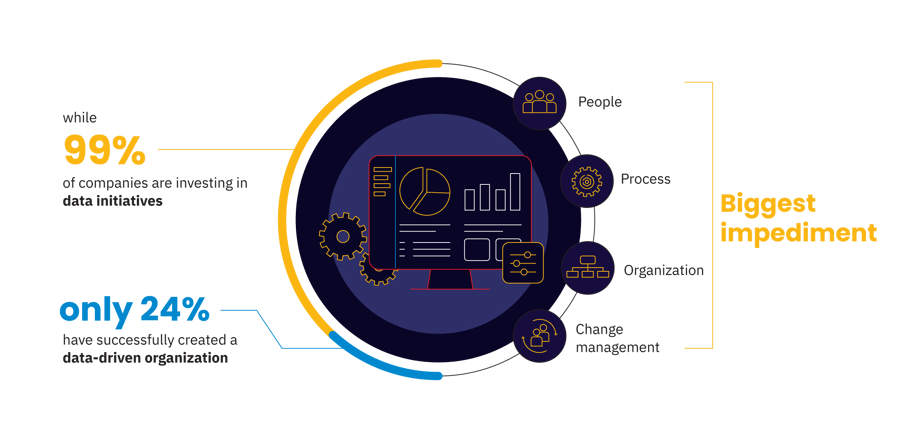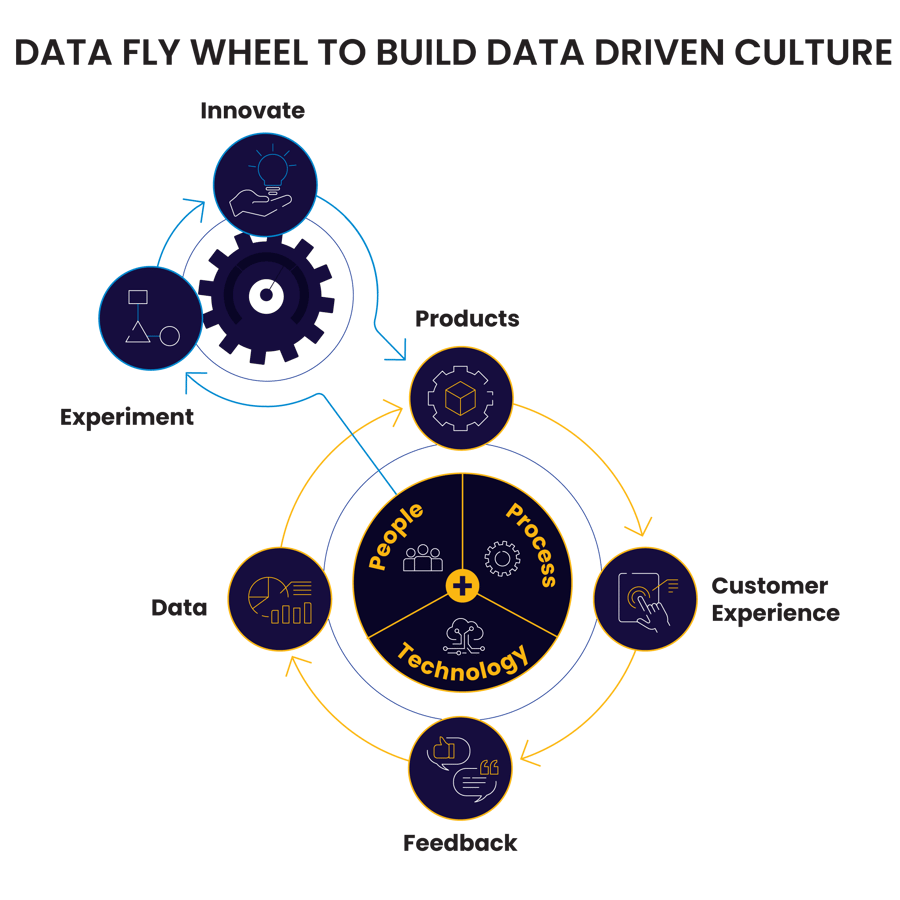In today's digital age, businesses recognize the importance of making data-driven decisions. Most data analytics implementations fail to deliver business value.
Despite this, 85% of companies still aim to be data-driven, with only 37% successfully achieving this goal. The main reason for this failure is the need for an aligned data culture between business and technology teams. The key factor in the success of this workshop-driven approach is the presence of a trained and skilled facilitator.

As you review the below, remember that your organization will need a skilled facilitator to ensure the success of implementing analytics solutions and drive alignment for meaningful business impact.
This article will provide readers with insights on a Workshop driven approach to resolving the gap between business and technology and how to design and implement analytics solutions that address their specific business objectives and challenges with a skilled facilitator.
Data-Driven Culture
Adopting a data-driven culture and completing a successful digital transformation to meet consumer expectations and stay competitive requires a different mindset from what businesses have traditionally held.

Successful companies have implemented a process like an
AWS D2E data flywheel to steer their innovation efforts. This flywheel represents an innovation cycle that enables thinking big about customer needs and aligning those needs with business outcomes. Then start small to quickly provide customers with a minimal viable product (MVP) version of a data-driven product or experience derived from the big idea. This MVP is just the first turn of the flywheel. Then you can iteratively scale up towards the big vision by deliberately measuring quantitative and qualitative feedback, where product teams can learn what delights customers, prioritize enhancements more efficiently, experiment more frequently, and continuously innovate with the guiding principle of "Think Big, Start Small, and Scale Fast."

However, living up to this principle necessitates a mindset shift and cultural transformation. This workshop is designed to help businesses obsess over their customers, build new collaboration muscle between teams, and adopt product thinking experiments early and often to empower data-driven action. Please find the detailed one-pager from the
AWS D2E landing page.
Establishing the Mindset
Each team member must agree regarding the following four cultural values in a data-driven enterprise.
- Customer Obsession: A business should analyze customer data to understand their behaviors, preferences, and pain points. By prioritizing customer satisfaction and putting their needs first, businesses can build loyal customers more likely to recommend their products or services to others.
- Build new collaboration muscle between business and technology teams: Collaboration is essential to a successful business. When working together effectively, teams can share knowledge, skills, and resources to achieve common goals. Building a culture of collaboration requires clear communication, respect for different perspectives, and a willingness to work together to solve problems.
- Adopt product thinking to experiment early: This means taking a product-focused approach to problem-solving and decision-making. By focusing first on the customer needs and experiences to create, you can iterate based on customer feedback to drive the desired business outcomes.
- Often empower data-driven action: Data is a valuable asset that can drive businesses to make informed decisions. Companies can identify patterns, trends, and opportunities by collecting and analyzing data to optimize performance. Empowering data-driven action involves providing employees with the resources and tools needed to collect, analyze, and interpret data and encouraging a culture of data-driven decision-making.
These ideas are summarized from AWS D2E Process. Please read more in this whitepaper.
Understanding the Business Growth Opportunities and Current Challenges
The first step in implementing analytics solutions is understanding the business growth opportunities and current challenges. This includes identifying the key performance indicators (KPIs) the organization wants to improve, the available data sources, and the current analytics capabilities. This section will discuss how to gather this information through interviews with key stakeholders, surveys, and data analysis.
One way to gather information is to interview key stakeholders from different business units or departments. This includes individuals responsible for setting the business strategy, managing operations, or analyzing data. During the interviews, it is important to ask open-ended questions to understand the stakeholders' perspectives, needs, and expectations. Some examples of questions to ask are:
- What are the top priorities for the organization in the next 12-18 months?
- What are the key performance indicators that the organization wants to improve?
- What are the data-related challenges that the organization is currently facing?
- What kind of analytics capabilities does the organization have in-house?
- What kind of data sources are available, and how are they managed?
In addition to interviews, surveys can gather information on a larger scale. Surveys can be distributed to a broader group of stakeholders, such as employees, customers, and partners. The survey questions should be designed to gather specific information on the business objectives and challenges.
- On a scale of 1 to 5, how important is it for the organization to improve the following KPIs: revenue growth, new areas to add revenue, customer satisfaction, operational efficiency, etc.?
- On a scale of 1-10, how would you rate your team's ability to analyze and make decisions based on data?
- What data-related obstacles prevent your team from making data-driven decisions?
- Which business functions would benefit most from more comprehensive data analysis?
- What are the current KPIs you use to track the success of your team or department?
- How frequently are those KPIs measured and reported?
- Which data sources do you rely on most heavily for decision-making?
Another way to understand the business objectives and challenges is to analyze the existing data sources. By reviewing historical data, it is possible to identify patterns, trends, and anomalies that can inform the analytics requirements. For example, if the organization wants to improve customer satisfaction, it may be helpful to analyze customer feedback data to identify common themes or issues.
Once the necessary information has been gathered, it is essential to prioritize the business objectives and challenges. This involves selecting the most relevant and impactful KPIs for the organization. It also involves identifying the data-related challenges that have the highest priority and require immediate attention. By prioritizing the objectives and challenges, you can then facilitate a focused workshop to ideate and solve the most critical areas for the organization.
Designing the Analytics Workshop
Once the business objectives and challenges have been identified, the next step is to choose the right analytics workshop. The workshop is a collaborative process that brings business and technology stakeholders from different departments to discuss their needs and expectations for analytics solutions.

This section will discuss the critical elements of the workshop, such as the agenda, the facilitation techniques, and the deliverables. It will also discuss incorporating different perspectives and ensuring the workshop outcomes align with the business objectives.
The first step to designing a workshop is nominating a skilled facilitator. Here are some characteristics of a data-driven workshop facilitator who can work between business and technology teams:
- Strong Communication Skills
- Knowledge of Data Analytics
- Problem-Solving Skills
- Collaborative Mindset
- Flexibility and Adaptability
- Project Management Skills
- Attention to Detail
Once such a person is identified, several vital elements must be considered when designing the analytics workshop. In the following section, I am sharing some notes on “How to set a workshop agenda? Amazon’s Working Backwards philosophy carefully crafts that.
How to set a “Workshop Agenda”?
A Workshop Facilitator should set the agenda to collaborate on the following eight items.
- Defining a customer persona and their problems and opportunities: To create a successful data-driven approach, it is essential to understand the persona of the customer you are trying to reach. This means defining their characteristics, needs, pain points, and opportunities for improvement. By understanding the customer's persona, you can tailor your data-driven approach to address their needs and goals.
- Define data-driven value stories for customers: Data-driven value stories are narratives that communicate the value stories to generate hypotheses to solve business/customer opportunities. By crafting compelling stories demonstrating the potential impact of data-driven decision-making, you can help customers understand the value of your approach.
- Define the “Big Idea” and benefit: The “Big Idea” is the central concept behind this workshop. The idea is that the most impactful data product and actionable insights that would be most valuable in addressing a business challenge or opportunity defined for the workshop use case focus will guide your data collection, analysis, and decision-making. By defining the “Big Idea,” you can articulate the benefits of your approach and demonstrate the value it can provide.
- Visualize Your persona's future state experience: Better To understand your data-driven approach's impact on your customers, it is important to visualize their future state experience. This means creating a vision of how the customer will interact with your product or service and how it will benefit them.
- Write the press release: The Press Release is a way to bring the big idea to life, much like the future state experience, aka storyboards. By working backwards from the customer methodically and ideating ways to meet their needs, a unique way to document these innovations is by writing a press release (PR) as if we are announcing the new product or service to the world.
- Write “FAQs” to bring clarity to the “Big Idea”: Creating a list of frequently asked questions (FAQs) can help bring clarity to the “Big Idea” and address potential concerns or questions from stakeholders. You can build support for your data-driven approach by anticipating questions and providing clear answers.
- Identify the data consumption mechanisms: Define the tools and resources used to collect, analyze, and visualize data. This could include dashboards, widgets, ad hoc analysis tools, and search capabilities.
- Define the “success criteria” for the program: Identify the metrics that will be used to measure the success of the data-driven program. You can track progress and adjust by defining clear and measurable success criteria.
- Analyze the availability of the data sources for the “Big Idea”: Identify the data needed to support the “Big Idea” and assess whether that data is available, accurate, and reliable.
- Define the scope of the Minimum Viable Product or “MVP” that can be delivered in 60 days: Identify the key features and capabilities that can be delivered rapidly and still delight your customers. This can help you establish a roadmap for your data-driven approach and build momentum for the program.
- Define MVP “Challenges” and “Opportunities” from “People” and “Technology” perspectives: Identify the potential obstacles and opportunities that may arise during the development and implementation of the MVP. This could include challenges related to people (such as lack of skills or resources) or technology (such as data quality or integration issues). By identifying these challenges and opportunities early on, you can develop strategies to overcome them and ensure the success of your data-driven approach. Commitment from key stakeholders can also help remove any blockers from delivering the MVP.
Implementing the Analytics Solutions
The workshop outcome results in stakeholders' alignment on the future state vision and the recommendation on the path (including the MVP to start) on how to get there. The next step is to begin to implement the analytics solutions. Ensuring that the analytics solutions are aligned with the organization's goals, and objectives are important.
Implementing analytics solutions requires several key steps, including selecting the right analytics software or platform, preparing and modeling the data, visualizing the data, deploying the solutions, testing and monitoring, and iterating and improving. To ensure success, solutions must be aligned with the organization's goals and objectives, data sources, user needs, and technical infrastructure to ensure success. By following these best practices, organizations can implement analytics solutions tailored to their needs and requirements and drive meaningful business impact.
Sustaining the Results
Analytics solutions should not be treated as a one-time project. Organizations must establish a culture of data-driven decision-making and continuous improvement to sustain the results. This section will discuss measuring the impact of analytics solutions, communicating the results to stakeholders, and developing a roadmap for future enhancements. It will also discuss building the necessary skills and capabilities within the organization, such as data literacy, data governance, and change management.
Here are the most critical steps in sustaining the results of analytics solutions.
- Measure the Impact: The first step in sustaining the results involves defining success metrics, tracking them over time, and communicating them to stakeholders. Success metrics can include KPIs such as revenue growth, customer retention, or operational efficiency. By measuring the impact of analytics solutions, organizations can identify areas for improvement and demonstrate the value of analytics to stakeholders.
- Communicate the Results: Once the impact has been measured, the next step is communicating the results to stakeholders. This can involve creating reports, dashboards, or presentations summarizing insights and highlighting the impact. Effective communication ensures the insights are understood, and the stakeholders are motivated to act on them.
- Develop a Roadmap for Future Enhancements: After communicating the results, the organization should develop a roadmap for future enhancements. This involves identifying the next analytics solutions to address the organization's priorities and challenges. The roadmap should align with the business objectives, data capabilities, and stakeholder expectations to drive long-term impact. Build the Necessary Skills and Capabilities: Sustaining the results of analytics solutions also requires organizational skills and capabilities. This includes developing data literacy skills, establishing data governance practices, and promoting a culture of data-driven decision-making. Training programs, mentoring, and coaching can be used to build these skills and capabilities. By investing in developing these skills, the organization can ensure that the analytics solutions are used effectively and that the insights are acted upon.
- Continuously Monitor and Improve: Finally, monitoring and improving the analytics solutions is important. This involves testing, monitoring, and iterating the solutions over time. It also involves staying current with the latest analytics trends, technologies, and best practices. By continuously monitoring and improving the solutions, the organization can stay ahead of the competition and continue to drive business impact.
In summary, sustaining the results of analytics solutions requires measuring the impact, communicating the results, developing a roadmap for future enhancements, building the necessary skills and capabilities, and continuously monitoring and improving. By following these best practices, organizations can ensure that their analytics solutions drive sustained business impact and support their long-term growth and success.
Conclusion
In today's data-driven world, it is essential for companies to have a data-driven approach to remain competitive and meet consumer expectations. This requires a shift in mindset and culture, which can be facilitated through steps in a workshop, including defining the customer persona and their problems, creating data-driven value stories for customers, visualizing the persona's future state experience, and defining the scope of a big idea and ultimately a Minimum Viable Product as an outcome that can be implemented to start small and scale fast!
To successfully facilitate this process, a workshop facilitator should possess key characteristics such as strong communication skills, knowledge of data analytics, problem-solving skills, a collaborative mindset, flexibility and adaptability, project management skills, and attention to detail. Through the help of a skilled facilitator, businesses can embrace a data-driven approach and thrive in the ever-evolving landscape of technology and consumer expectations.
Mactores is your trusted partner for implementing analytics solutions with a workshop-driven approach. As one of only seven US companies certified by AWS for data analytics competencies and service delivery, we have over 100 certified facilitators with extensive experience navigating complex team collaborations and delivering valuable outcomes. Our expert facilitators will help keep the conversation focused on your business objectives and challenges, ensuring that all stakeholders are heard and that you create an environment for innovation. Partner with Mactores to increase the likelihood of success in implementing analytics solutions and drive meaningful business impact. Contact us today to achieve your goals.
Talk to us today to set up your workshop



